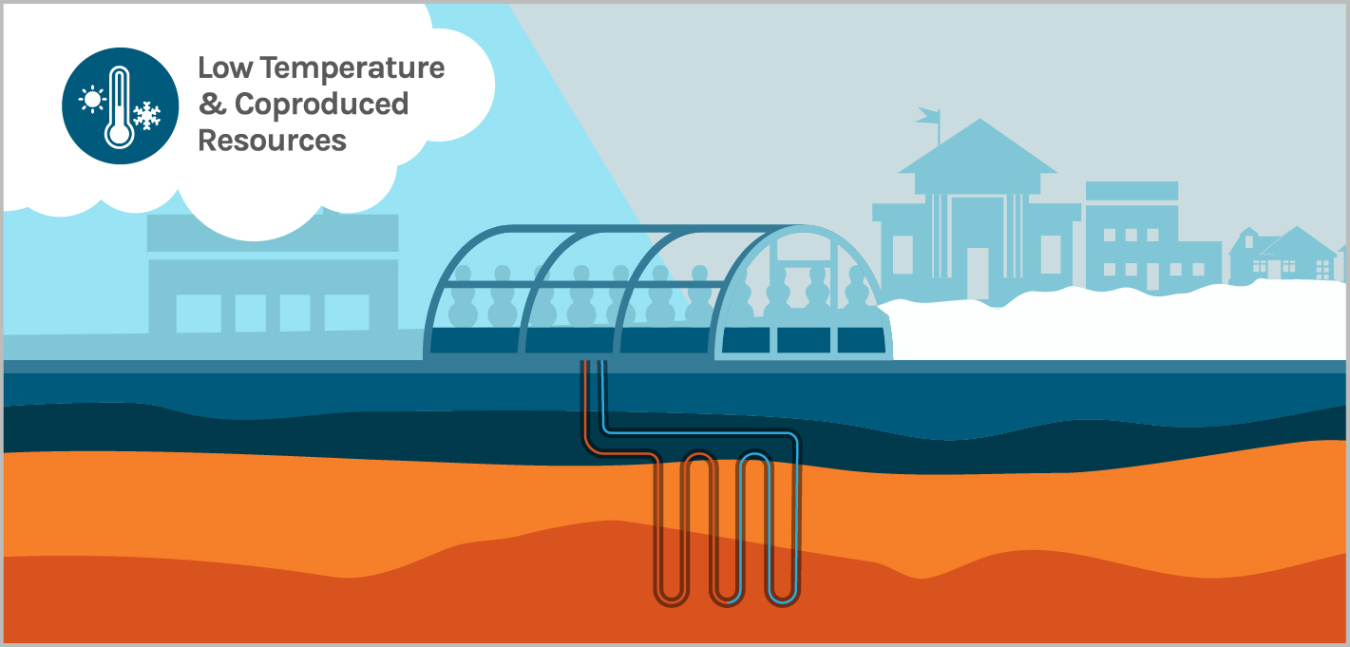
What Are Low Temperature Geothermal Resources?
Low-temperature geothermal resources are generally considered those below 300°F (150°C). Low-temperature geothermal uses include geothermal heat pumps (GHPs) for individual homes and businesses, district heating and cooling, and direct-use applications, where water from the geothermal resource is piped through heat exchangers or directly into commercial or residential buildings to meet heating and hot water demands. These resources can meet many energy needs, from heating and cooling to industrial processes like paper drying, greenhouses, and even beer brewing.
Low Temperature and Coproduced Resources Program
The Geothermal Technologies Office’s (GTO) Low-Temperature and Coproduced Resources program conducts research, development, and demonstration (RD&D) activities focus on improving the efficiency of low-temperature geothermal systems and expanding their utility through additional revenue streams.
The program also researches the direct use of thermal resources for energy storage as well as process and space-heating applications, which have the potential to provide cost-effective, reliable thermal energy in large portions of the United States.
Low-temperature geothermal energy resources can be used by a wide array of community customers, including urban centers, rural areas, and remote communities.
Power Generation from Low-Temperature Resources
Increasingly, low-temperature resources below 150°C—once reserved for direct-use applications such as heating, greenhouses, fisheries, and mineral recovery—can now be used for power generation under the right conditions using binary cycle electricity generating technology.
Hybrid Technologies
Under certain conditions, geothermal energy can be harnessed in combination with other energy technologies. Many types of hybrid systems exist and are commercially deployed already. GTO supports work to expand the efficiency and use of these systems, including through hybrid demonstrations as well as research on solar hybrids at geothermal fields and reservoir thermal energy storage (RTES).
Check out these reports to learn more:
- U.S. Department of Energy. (2019). Geothermal Hybrid Systems: GeoVision Analysis Supporting Task Force Report. INL/EXT-17-42891 PNNL-27386.
- National Renewable Energy Laboratory. (2015). Stillwater Hybrid Geo-Solar Power Plant Optimization Analyses. NREL/CP-5500-64535.
- National Renewable Energy Laboratory. (2018). Solar-Driven Steam Topping Cycle for a Binary Geothermal Power Plant. NREL/TP-5500-71793.
Reservoir Thermal Energy Storage
Reservoir thermal energy storage (RTES) takes advantage of large storage capacities, geothermal gradients, and thermal insulation in the subsurface to store thermal energy directly in underground reservoirs. This energy can be stored for 100 or more hours and then extracted for use in processes like concrete or chemical production, lumber drying, and textile manufacturing.
Direct Use
One of the most common direct-use geothermal applications is geothermal district heating, where hot water is piped from underground directly into heat exchangers or buildings. The oldest geothermal district heating system is in Boise, Idaho, and has been in operation since the 1890s.
Other direct-use applications include greenhouses, aquaculture, food processing like agricultural drying and beer brewing, and industrial uses where process heat is required (e.g., pulp and paper processing, and drying of cement, aggregate, lumber, and other materials).
Technology Commercialization Fund
The Technology Commercialization Fund (TCF), coordinated by DOE’s Office of Technology Transitions and supported by nine DOE program offices, enables flexibility to promote promising energy technologies. In order to flexibly meet the power and thermal demands of buildings in an energy-efficient manner, Oak Ridge National Laboratory and Purdue University have invented a new technology, the dual-purpose underground thermal battery (DPUTB), under a TCF-funded project. The DPUTB integrates a ground heat exchanger and underground storage, enabling a building to reduce its peak electric demand and reduce its power consumption by 11% compared with the conventional heating, ventilation, and air conditioning system. This novel geothermal heat pump technology produces operational efficiency and energy savings in a simulated residential building with its ability to shift or level the electric load while reducing power consumption.
GTO emails bring geothermal funding opportunities, events, publications, and activities directly to your inbox.


